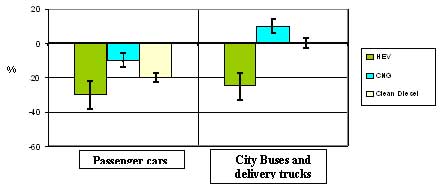
Advanced Vehicles
HEVsEVs
PHEVs
Clean Diesel
Natural Gas Vehicles
Comparison of clean diesel vehicles, CNG vehicles, and HEVs
There are three major aspects to be considered when choosing an alternative vehicle; emissions, energy, and economics.
Emissions
All currently available alternative vehicles have fewer emissions compared with standard vehicles, and can also meet future stringent emissions reduction criteria (such as EURO V, which comes into effect in 2008, and American Tier II standards, which came into effect in 2007). However, owing to more stable engine operation conditions, HEVs have an advantage over conventional engine design in terms of emissions. CNG vehicles are preferable to diesel vehicles due to the use of cleaner-burning fuel. The size of this difference depends on the exact nature of the fuel and utilization of emissions control technologies.
Energy
The major difference between the alternative vehicles on the market today is the reduction potential for fuel consumption and thus CO2 emissions. In the figure below, the fuel reduction potential of HEVs, CNG and clean diesel vehicle technologies is given.

For HEV passenger cars, the potential reduction in energy use is substantial, ranging from 30-40% reduction when compared with petrol vehicles. For HEV city buses and delivery trucks – which have a lot of stop-and-go movement – the fuel reduction is around 25-30% for state-of-the art hybrid buses/delivery trucks when compared with standard diesel buses.
The benefits of HEVs depend on the circumstances under which they are driven (i.e. the drive cycle). The more stop-and-go traffic, the greater the fuel reductions.
Replacing petrol vehicles with CNG passenger cars can reduce energy use by approximately 10% in terms of the petrol equivalent. Replacing diesel vehicles with CNG buses and delivery trucks uses more energy, because diesel buses are highly efficient. A purpose-built CNG bus that replaces a diesel bus is estimated to use 10-15% more energy, whereas a retrofitted CNG bus is estimated to use about 10-40% more energy.
The economics/life-cycle cost
Buying a hybrid vehicle or a CNG vehicle is more costly, but given the lower fuel consumption, the total life-cycle cost can be equal or lower than that of a conventional car. The life-cycle cost does not only include the cost of buying the vehicle, but is comprised of the total costs accrued during the vehicle lifetime, including costs such as fuelling and maintenance.
The costs of buying and fuelling HEVs: Currently, a HEV passenger car costs approximately $3000 -$6000 more than a conventional model. This estimated cost does not include government rebates and incentives offered in some countries, which can be anywhere from $300 to $2500. The “pay-back time” for the extra purchase price of a HEV can be calculated based on mileage, fuel prices, and actual fuel savings.
The costs of buying and fuelling CNG vehicles: Compared with standard vehicles, the extra cost for CNG passenger cars (usually sold as bi-fuel vehicles) are similar to that for HEVs. CNG vehicles consume up to 10% more fuel compared to standard vehicles, but CNG fuel is generally less expensive. However, the infrastructure needed to fill the cars is costly. The profitability of this option depends heavily on price of CNG fuel and on the cost for establishing a network of filling stations.
The costs of buying and fuelling a clean diesel vehicle: Currently, the extra cost of buying a passenger diesel car with a particulate filter is around $300-$500. At the moment, the extra cost of buying an Euro V truck is not known, and will depend on factors such as how many are ordered, etc. As soon as the Euro V standard is mandatory for vehicles, the price difference will disappear.
Maintenance costs for HEVs and CNG vehicles: The maintenance costs of CNG and HEV passenger cars are comparable or even lower than their diesel and petrol counterparts.
Hybrid-electric Vehicles (HEVs)
Hybrid-electric vehicles (HEVs) use two power sources, a petrol or a diesel engine, and a battery pack that also powers the vehicle. These vehicles generally shut the engine off when it is appropriate to run on the batteries, thereby improving fuel consumption. These vehicles are also known as power-split hybrids. Diesel-electric hybrids are also being developed, which generally exhibit even lower fuel consumption.
Hybrids have the potential to reduce smog pollution by 90% or more compared with the cleanest conventional vehicles on the road currently. As HEVs use less gasoline than conventional vehicles, they typically reduce fuel consumption and GHG emissions by between 30-50%. And, when considering the costs over the life of a hybrid vehicle, they are competitively priced.
- Serial: the internal combustion engine is only used to charge the battery and the electricity stored in the battery is used to power the motor that drives the wheels. The ICE is used at a nearly constant load most of the time, where its efficiency is best;
- Parallel: an ICE and one or more electric motors are able to deliver power to the wheels via the transmission. Use a smaller battery pack and therefore rely mainly on regenerative braking to keep it recharged.
- Combined: a power-splitting device is used to enable an ICE and one or more electrical motors to operate together depending on the driving conditions and the state of charge of the battery. This dual drivetrain allows the engine to operate at near optimum efficiency more often.
There are three basic types of HEVs:
UNEP has published a technical and policy overview of HEVs: current technology and its application in developing and transitional countries. For a more condensed overview of HEV technology, see ICCT’s Hybrid Vehicle Handout.
A useful link to compare different hybrid vehicles is the Union of Concerned Scientists’ Hybrid Center.
Full hybrid potential fuel economy benefit – [30-80%] Mild hybrid potential fuel economy benefit – [5-7%]
Electric Vehicles (EVs)
"Fully electric vehicles – if using zero or low-carbon electricity – offer the most direct opportunity to de-carbonize road transport over the longer term"
Electric vehicles (EVs) encompass a broad range of technologies. Pure electric vehicles use batteries alone as their motive power source. A pure electric vehicle is a zero-emission vehicle – its total emissions depend on the source of power to charge it. EVs offer a very high level of efficiency and relatively low costs for the electric motor. However, they rely exclusively on batteries, which are a costly, heavy and cumbersome means of storing energy. However, further development of battery technology is likely to result in increased the range, lower costs and shorten recharge time.
High costs, limited storage capacity and heavy loads for the batteries may limit the range of EVs, making them most appropriate for urban settings, where the majority of trips are 5kms and under, and recharging infrastructure is more easily set up.
Electricity’s share of transport fuel across all modes worldwide is less than 1%. But, electricity is likely to play an increasing role in the transport sector as in other sectors, particularly in a low CO2 future. If electricity can be produced with low net GHG emissions and if electricity storage systems on vehicles improve, it may be possible to de-carbonize transport progressively. The extent of this decarbonisation will depend on the availability of low-GHG electricity, technological developments in vehicles and storage systems such as batteries, and shifts to transport modes and vehicle types that can use electricity as a fuel.In Britain, under the current electricity grid mix, electric vehicles power consumption represents just over a 50% CO2 saving compared to petrol/diesel vehicles, and will increase as the electricity sector continues to decarbonize. If, today, the entire UK car and taxi fleet were converted to electricity, it would equate to 16% of current electricity demand, and could be set to charge when the demand for electricity is low, such as at night.
Electric vehicles can also help to regulate a renewable electricity grid by providing a significant variable load, with smart chargers programmed to draw electricity from the grid at low peak (ie. at night when wind turbines are most active). This illustrates that it is possible to run a significant number of electric vehicles without having to build any more electricity generation capacity, while further making renewable energy more cost effective and better able to compete financially against fossil fuels by enabling more of the energy they generate to be used.
Lithium is one of the main elements used in the production of lithium-ion batteries – batteries used in electric vehicles. Currently, the price of lithium-ion batteries is extremely expensive, typically around USD 500/kWh to USD600/kWh for a vehicle with a driving range of around 150km – or USD 16000 to USD 20000 per vehicle. However, as the technology progresses and economies of scale are reached, the price will inevitably come down.
Unlike oil, which is a scarce natural resource, lithium is an extremely abundant resource, with current reserves coming from a few countries with cheap extraction costs. However, expensive extraction costs are not likely to affect the price of lithium-ion batteries too much, as lithium itself only accounts for around 1% of the final battery price.
Plug-in Hybrid-Electric Vehicles (PHEVs)
Plug-in hybrid-electric vehicles (PHEVs) are hybrids with the means to charge their battery packs from an outside source (usually the electric grid). These vehicles generally have a larger battery pack with more energy storage and a greater capacity to be discharged in a wide range of driving conditions. There are two major hurdles before PHEV reach mass distribution: range considerations linked to battery costs and recharging infrastructure. For PHEVs to become affordable on a wide-scale, battery costs will have to decrease from $1000-$500/kWh to less than $350/kWh. The potential for costs to reduce substantially exists; however, production must reach and exceed 100,000 units before economies of scale allow for affordability. Adequate recharging infrastructure and recharging speed of batteries must be addressed through innovative partnerships amongst vehicle and battery manufacturers, electric utilities and local governments.
PHEVs function in the same way as convention hybrids, in that the ICE can recharge the battery and work with the electric motor in a charge-sustaining mode. Battery power from PHEVs may also be used when they are stationary to either offset electricity grid demands, or to help stabilise the electricity grid.
Clean diesel vehicles
Diesel engines are inherently more efficient than conventional petrol engines; for passenger cars, benefits are estimated to be an approximate 20% reduction in energy use. Heavy-duty vehicles already use diesel technology, so the benefits with "clean diesels" arise through a sharp reduction of regulated pollutants.
Natural gas vehicles
Natural gas vehicles (NGVs) have several environmental benefits, such as reduced local air pollution. Compared with diesel buses or heavy-duty and light duty diesel/gasoline vehicles, NGVs have the potential to emit lower levels of particulate matter, non-methane organic gases/reactive organic gases (NMOG/ROG), nitrogen oxides (NOx), carbon monoxide (CO), and air toxics. Also, they have the benefits to lower cold-start emissions and off-cycle emissions, and to reduce evaporative emissions and running-loss emissions. NGV programmes are already prominent in Asia Pacific and Latin America. The 2010 International Energy Agency paper on NGV’s The Contribution of Natural Gas Vehicles to Sustainable Transport take an in-depth look at NGV programmes and potential for energy efficiency.







